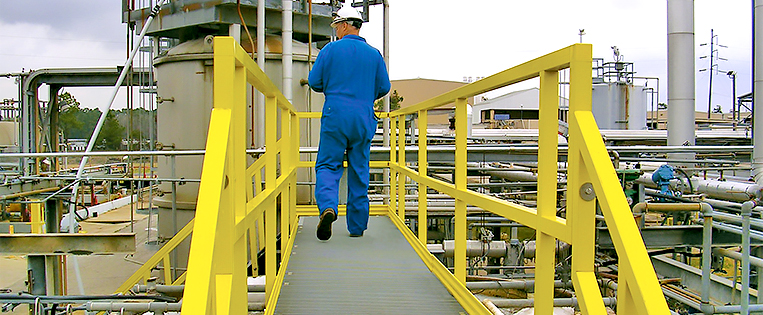Where to Find Industrial Catwalks
Efficiency is at the heart of success in industrial settings, and even the smallest bottleneck can ultimately affect a business’s profitability. If workers cannot effectively access factory floors and warehouses—whether for safety reasons or for a lack of space—it can have a tangible impact on throughput/operating efficiency. Raised industrial catwalks were envisaged as an economical solution to space issues in not just processing environments, but in critical infrastructure, municipal architecture, product berths, storage warehouses, and more.
Industrial Catwalks, Platforms & Walkways
Conventional catwalks are occasionally made from wood but are more typically manufactured using aluminum or steel; high-strength metals which offer decent levels of corrosion resistance. Yet they raise several cost inconveniences from an initial construction perspective through to ongoing maintenance concerns. Plus, metal catwalks add a significant load to any facility, requiring extensive reinforcements to ensure they will stay safely suspended for the duration of their lifespan.

Fiberglass industrial catwalks outperform metal systems on virtually every front. Durable, inherently corrosion-resistant, and boasting an unmatched strength-to-weight profile compared with other engineering materials, fiberglass catwalks are increasingly preferred to their metal counterparts across the full spectrum of application. Here are a few success stories:
Catwalks for a Marine Environment
Fiberglass materials were used to fabricate a raised catwalk extending one mile over the bay at LaGuardia Airport, New York, contending with heavy foot traffic, a harsh saltwater environment, and corrosive jet emissions. As the entire system (down to the bolts and flange beams) is non-conductive, it exhibits zero interference with crucial radar transmissions and simultaneously improves worker safety. This industrial catwalk saved an estimated $16.5 million dollars on maintenance costs associated with the previous wooden platform system.
View the LaGuardia Airport Industrial Catwalk Case Study
Lightweight Catwalk in a Hangar
Likewise, a new catwalk was required at a FedEx 747 hangar in Anchorage, Alaska. This platform needed to be suspended 200-feet off the ground without adding additional stress to the roof supports. Thus, it needed to be as light as possible. A DURAGRID® I-7000 grating system was used to construct an extremely lightweight system which has dramatically improved safety and efficiency at the mail-sorting facility.
View the Anchorage Airport Catwalk Case Study
Industrial Catwalks for Processing Environments
Lastly, a successful U.S. leather tannery that had been running successfully for 150 years required a brand-new industrial catwalk system capable of withstanding the harsh environment associated with the chrome tanning process: constant moisture; chemical processes; and extreme temperatures are the norm. A safety-yellow DURAGRID® system was installed using existing support structures, which cut mandatory downtime for installation and allowed the tannery to restart operations as quickly as possible—quickly realizing the durability and corrosion prevention benefits of their new industrial catwalk.
View the U.S. Leather Tannery Walkway Case Study
If you would like to learn more about the underlying systems used to create these custom-built raised platforms and mezzanines, refer to our fiberglass grating product page for full benefits and specifications.